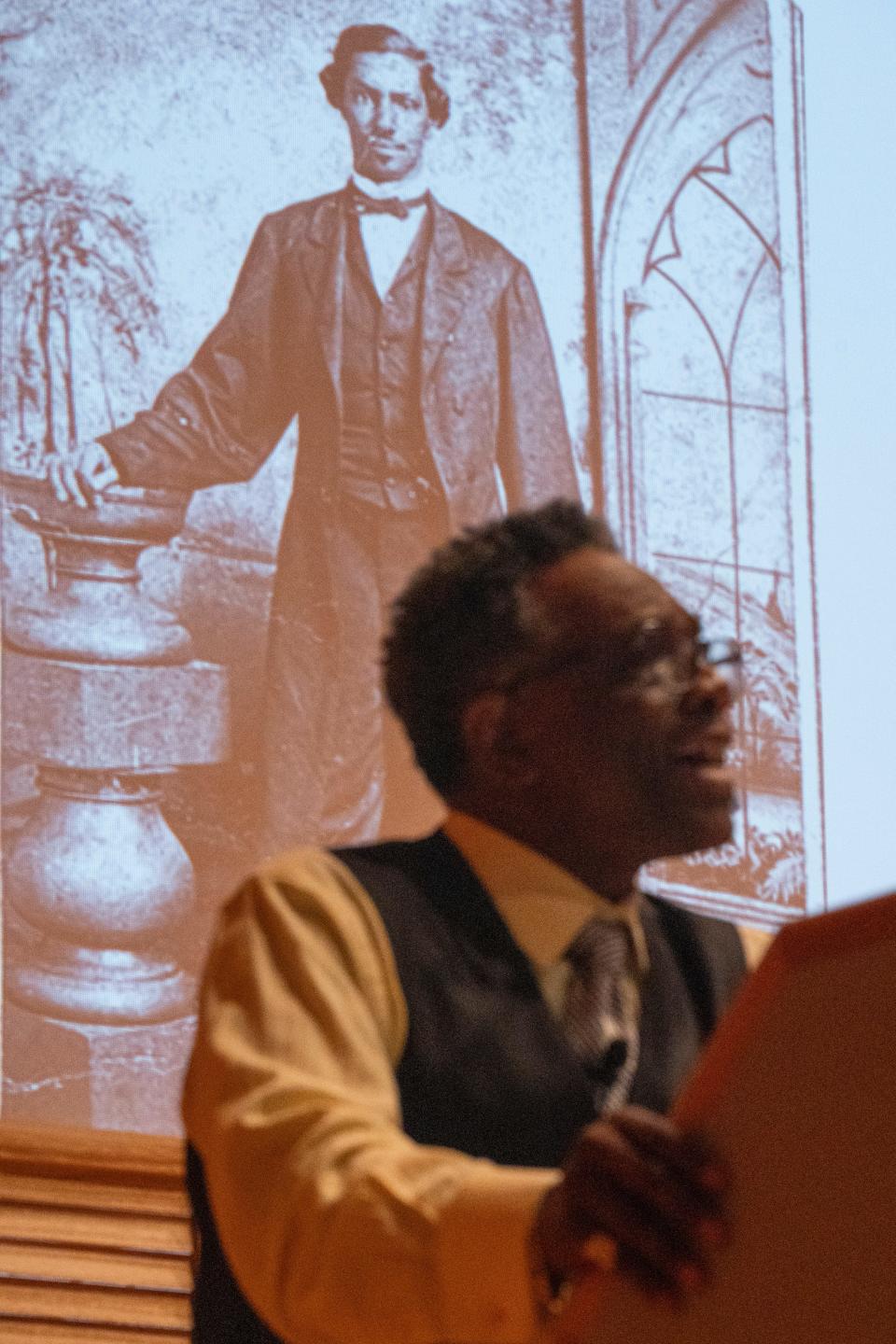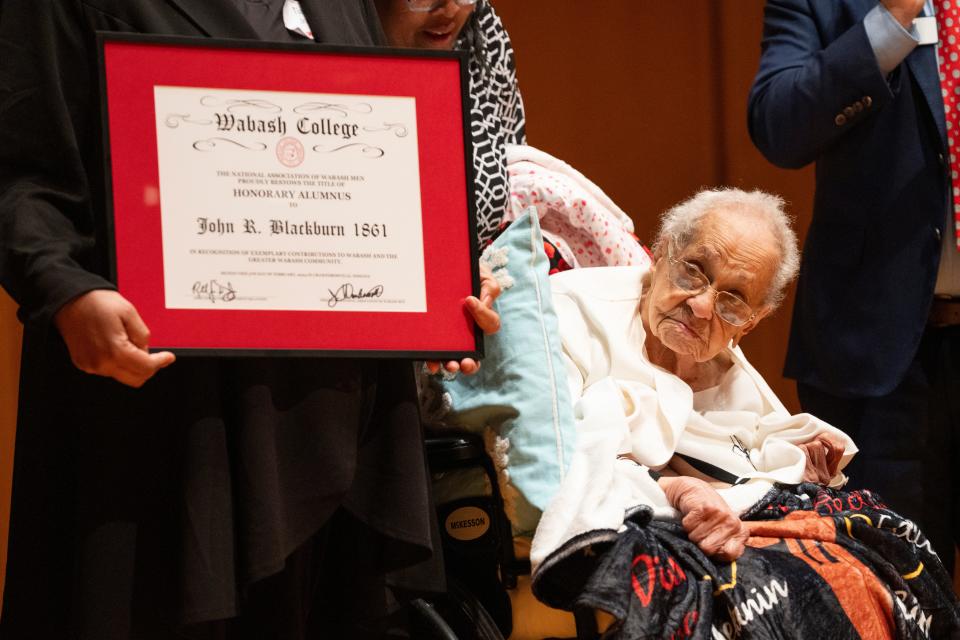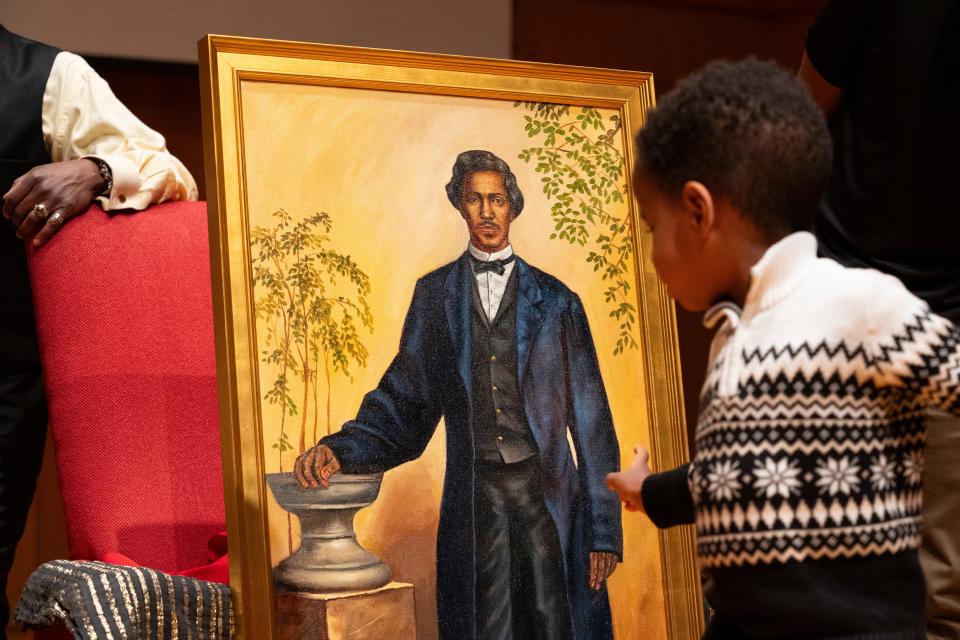Wabash College’s first Black student just got his degree — 167 years later
When Tim Lake, associate professor of English and Black Studies at Wabash College, arrived in Crawfordsville 21 years ago, he asked his colleagues who the school’s first Black student was. They told him about Wabash's first Black graduate: John Evans, class of 1908, a coal miner and shoe shiner who parlayed his degree into an illustrious career in education.
“But when I asked, ‘Who was the first African American to be enrolled in the college?’” Lake said, “I was told a story.”
According to the story Lake heard from colleagues, Wabash admitted a Black student in January 1857, just 25 years after the college was founded. While the debate over slavery and the rights of Black people raged throughout the United States, Wabash was governed largely by Presbyterian New Englanders who identified as abolitionists. And in that abolitionist spirit, Wabash took the bold step of admitting a Black student.At the time, Indiana University had yet to admit a Black student. Nor had Earlham College, just 10 years old itself. That did not deter Wabash. However, admitting a Black student did not go well for the all-men's college.
“Because of the racial backlash among people in the town, it created such a firestorm of racial animus that the student ended up leaving the college,” Lake said.The story that Wabash told for more than 150 years placed no blame on the college itself for the anonymous student's untimely departure. Intent to find the student’s name, Lake began poking around school and local newspaper archives — which he did for more than 16 years.And the more he learned, the more determined he became to correct the narrative.
“The story that has circulated for 167 years, the story about ‘The Negro’ at the college, was almost all false,” he said.
Lake believes he now knows the full story, which he stitched together from school records, local newspaper accounts, letters and other documents.
The true story of Wabash's first Black student
The narrative begins in 1841 in Essex County, Virginia, where John Randall Blackburn was born to white planter William Blackburn and Fannie Randol, one of William’s slaves. William emancipated Fannie and the Blackburn children in the late 1840s and moved the family to Cincinnati, where census data shows William remained for a short period.
After William returned to Virginia — he remained a slaveholder there — John Blackburn attended school in southwest Ohio. In 1856, he traveled to Crawfordsville and enrolled at Wabash on Jan. 1, 1857.
Little is known about Blackburn’s brief experience at Wabash. He didn’t live on campus — Black students couldn’t live on campus until the 1950s — instead staying with James Askins, a prominent Black barber in Crawfordsville.
While the school historically said Blackburn left of his own volition, Blackburn wrote in a brief memoir published shortly before his death in 1937 that he was “sent away.” Around the same time as Blackburn’s dismissal, two white students were also dismissed.
Lake suspects the backlash that led to Blackburn’s departure came from within the Wabash student body, not the surrounding community, because newspaper accounts of Blackburn’s time in Crawfordsville were published weeks after Blackburn left. Much of Crawfordsville wouldn't have even been aware of Blackburn's presence until he was gone.
Even with Blackburn gone, some in Crawfordsville were incensed the school had admitted a Black student in the first place. They threatened to withdraw support from the college and spread word that Wabash was practicing “mongrelization.”
In a scathing editorial published Feb. 14, 1857, the local newspaper the Crawfordsville Review skewered the college for taking “the first initiative steps in the revolting and damnable schemes” of abolition.
The reaction may have been fervent but blew over quickly.
Before long, Blackburn was back in Cincinnati, where he studied at Lane Theological Seminary. After a stint at Dartmouth College from 1859-1861, Blackburn embarked on a decorated 62-year career in education. He served as the Principal of Colored Education in Xenia, Ohio, and worked as a mathematics professor at what today is Alcorn State University. He received a Master of Arts from Dartmouth in 1883 and was a trustee for Ohio University and Wilberforce University.
All the while, Wabash was in the process of forgetting his name. Lake believes the school administration intentionally ignored his story, allowing it to fall into the recesses of history.
“I think that it’s a lost opportunity for racial justice and racial harmony and racial healing,” Lake said. “Wabash told this story about itself, and it was OK with telling the story and leaving out the name of ‘the Negro.’”

The story of John Blackburn at Wabash calls into question the commitment to abolition that Wabash's founders had, Lake said.
“What they didn’t say is they were a particular kind of abolitionist,” Lake said.
Lake, who has been at Wabash for over two decades, said he doesn’t want to disparage the institution. Nonetheless, nearly two centuries of ignoring Blackburn's experience at Wabash rattled Lake’s trust in the college.
“Is this college really ready to grow up, to take a hard look at its past and to not shy away from it?” Lake said. “I’m not so sure that it is. My fear is that I have participated in resurrecting this student so that he can be dismissed again.”
How Wabash is confronting its past
Around 8:30 p.m. on a recent Monday, Lake sits in the front row of a nearly full Salter Hall in Wabash’s Fine Arts Center. He’s just finished telling Blackburn’s story to more than 100 tudents, faculty and Crawfordsville residents. The vast majority are learning Blackburn’s name for the first time.
The 11 people standing on the stage opposite Lake, however, know the name well. They are Blackburn’s living descendants, hailing from as far west as Los Angeles all the way to 30 miles from the Chesapeake Bay.
Two years ago, Lake drew the connection between the prolific Ohio educator and the nameless Black student at Wabash and began searching for Blackburn’s descendants. Lake received an exception from Ancestry.com — which does not make living relatives visible to non-family members — and started sending letters across the country.
Five generations of Blackburn descendants came to Crawfordsville on February 5th. On one side of the stage, Christina Smith stood with her three-year-old daughter’s arms wrapped around her neck. Smith, now a small-business owner in Los Angeles, previously spent six years as a special education teacher, the latest in a long line of educators.
Seated in a wheelchair to Smith’s right was Blackburn’s centenarian granddaughter, Jeanne Blackburn Burch. Fast approaching her 104th birthday, Burch still has memories of her grandfather. She calls him a “handsome man.”

One of Burch’s granddaughters, Mariska Williams, knew about Blackburn’s time at Dartmouth and Ohio, but hadn’t heard of Wabash until Lake contacted them.
When they first arrived at Wabash, Williams and her family walked through the Malcolm X Institute of Black Studies building, where portraits of Wabash’s most esteemed men lined the walls. Williams wondered if her great-great-grandfather would join them.
Standing on the Salter Hall stage, Williams watched a scarlet curtain fall away to reveal the Institute’s newest portrait: John Blackburn, honorary class of 1861, broad-shouldered in a smart navy coat, pencil moustache and placid smile.
A tear formed in Williams’ eyes as applause filled the auditorium.
“When he turned that picture around — because of the beauty and the simplicity of the picture that just shows him, a man of color in stature — it was like larger than life,” she said.

As the crowd steadily dripped into the foyer for conversation and cake bites, Lake lingered behind to shake hands, slap backs and laugh. Still, Lake is hesitant to celebrate too quickly. Until he sees how Wabash treats future generations of Black and other marginalized students, he remains ambivalent.
“I don’t think history is destiny,” Lake said. “We can learn, we can grow from history. The question is: Will we?”
Contact IndyStar reporter Bradley Hohulin at bhohulin@gannett.com. You can follow him on Twitter/X @bradleyhohulin.
This article originally appeared on Indianapolis Star: Nameless no more: the story of Wabash College's first Black student

